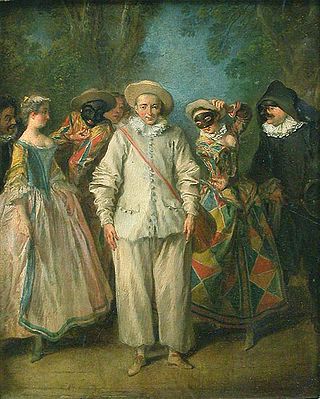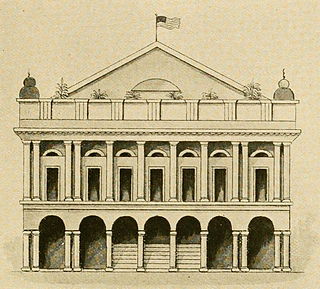Related Research Articles

In the context of the history of slavery in the Americas, free people of color were primarily people of mixed African, European, and Native American descent who were not enslaved. However, the term also applied to people born free who were primarily of black African descent with little mixture. They were a distinct group of free people of color in the French colonies, including Louisiana and in settlements on Caribbean islands, such as Saint-Domingue (Haiti), St. Lucia, Dominica, Guadeloupe, and Martinique. In these territories and major cities, particularly New Orleans, and those cities held by the Spanish, a substantial third class of primarily mixed-race, free people developed. These colonial societies classified mixed-race people in a variety of ways, generally related to visible features and to the proportion of African ancestry. Racial classifications were numerous in Latin America.

The Palais-Royal is a former French royal palace located on Rue Saint-Honoré in the 1st arrondissement of Paris. The screened entrance court faces the Place du Palais-Royal, opposite the Louvre. Originally called the Palais-Cardinal, it was built for Cardinal Richelieu from about 1633 to 1639 by architect Jacques Lemercier. Richelieu bequeathed it to Louis XIII, before Louis XIV gave it to his younger brother, Philippe I, Duke of Orléans. As the succeeding Dukes of Orléans made such extensive alterations over the years, almost nothing remains of Lemercier's original design.

The Comédie-Française or Théâtre-Français is one of the few state theatres in France. Founded in 1680, it is the oldest active theatre company in the world. Established as a French state-controlled entity in 1995, it is the only state theatre in France to have its own permanent troupe of actors. The company's primary venue is the Salle Richelieu, which is a part of the Palais-Royal complex and located at 2, Rue de Richelieu on Place André-Malraux in the 1st arrondissement of Paris.
Opéra comique is a genre of French opera that contains spoken dialogue and arias. It emerged from the popular opéras comiques en vaudevilles of the Fair Theatres of St Germain and St Laurent, which combined existing popular tunes with spoken sections. Associated with the Paris theatre of the same name, opéra comique is not necessarily comical or shallow in nature; Carmen, perhaps the most famous opéra comique, is a tragedy.
Plaçage was a recognized extralegal system in French and Spanish slave colonies of North America by which ethnic European men entered into civil unions with non-Europeans of African, Native American and mixed-race descent. The term comes from the French placer meaning "to place with". The women were not legally recognized as wives but were known as placées; their relationships were recognized among the free people of color as mariages de la main gauche or left-handed marriages. They became institutionalized with contracts or negotiations that settled property on the woman and her children and, in some cases, gave them freedom if they were enslaved. The system flourished throughout the French and Spanish colonial periods, reaching its zenith during the latter, between 1769 and 1803.

Pierre-Alexandre Monsigny was a French composer and a member of the French Académie des Beaux-Arts (1813).

Comédie-Italienne or Théâtre-Italien are French names which have been used to refer to Italian-language theatre and opera when performed in France.

Louis Gallodier was a French ballet dancer and choreographer who spent the majority of his career in Sweden, where he was to have a great importance for the development of the ballet in Sweden as the ballet master of the Royal Swedish Ballet.
Minette et Lise was a sister couple of two stage artists, active in Saint Domingue in Pre-revolutionary Haiti. They consisted of Elisabeth Alexandrine Louise Ferrand, stage name "Minette" and Lise. They have become known as Minette et Lise.
Jeanne-Marie Marsan, born Chapiseau, was a French dramatic actress and an opera singer, active in France, the Holy Roman Empire, the French West Indies and Louisiana. She was the leading actress and opera singer in Saint-Domingue, and later in the first theatre in New Orleans in Louisiana.
Jean Baptiste Fontaine, né Le Sueur, was a French actor and theatre director. He was director of the theatre Comédie du Cap in Cap-Francais and an actor and newspaper editor in New Orleans. He was known under his stage name Fontaine.

The Théâtre d'Orléans was the most important opera house in New Orleans in the first half of the 19th century. The company performed in French and gave the American premieres of many French operas. It was located on Orleans Street between Royal and Bourbon. The plans for the theatre were drawn up by Louis Tabary, a refugee from the French colony of Saint-Domingue (Haiti). Construction began in 1806, but the opening was delayed until October 1815. After a fire, it was rebuilt and reopened in 1819, led by another émigré from Saint-Domingue, John Davis. Davis became one of the major figures in French theatre in New Orleans. The theatre was destroyed by fire in 1866, but the ballroom is still used.
Théâtre de la foire is the collective name given to the theatre put on at the annual fairs at Saint-Germain and Saint-Laurent in Paris.

Jean-Pierre Solié was a French cellist and operatic singer. He began as a tenor, but switched and became well known as a baritone. He sang most often at the Paris Opéra-Comique. He also became a prolific composer, writing primarily one-act comic operas.

The Salle de la Bouteille or Salle du Jeu de Paume de la Bouteille, later known as the Hôtel [de] Guénégaud or Guénégaud Theatre, was a 1671 theatre located in Paris, France, between the rue de Seine and the rue des Fossés de Nesle. It was across from the rue Guénégaud, which ran behind the garden of a townhouse formerly known as the Hôtel de Guénégaud on the quai de Nevers. The theatre was the first home of the Paris Opera and in 1680 became the first theatre of the Comédie-Française. It closed in 1689 and was later partially demolished and remodeled for other purposes.
Comédie du Cap was a theater in Cap-Français in Saint-Domingue, active from 1740 to 1793; from 1764 as a public theater. It is regarded as a prototype for the theaters in Saint-Domingue, where theater was immensely popular.
François-Pierre-Auguste Léger was an 18th–19th-century French playwright.
Rosette Rochon (1767–1863) was an American placée and businesswoman, who was an important figure in the Gens de couleur libres society of New Orleans. She belonged to the most famous of the placées of New Orleans alongside Eulalie de Mandéville and Marie Thérèse Metoyer, and made a fortune on investments in dry goods, cattle, banking, slave trade and real estate business.
Mlle Marthe, was a French stage actress and theatre director, active in Saint-Domingue.

Marie-Françoise Desbrosses, was a French operatic mezzo-soprano. She made her stage debut at the Comédie-Italienne in 1776, at age 13, and remained with the company for almost five decades, creating several roles.
References
- ↑ Le Gardeur Jr., Rene J. (1963)"The First New Orleans Theatre, 1792-1803
- ↑ rench Secular Music in Saint-Domingue (1750-1795)
- ↑ Juliane Braun: Creole Drama: Theatre and Society in Antebellum New Orleans
- ↑ Juliane Braun: Creole Drama: Theatre and Society in Antebellum New Orleans
- John G. Cale, French Secular Music in Saint-Domingue (1750-1795) Viewed as a Factor in America's Musical Growth , Louisiana State University and Agricultural & Mechanical College, 1971
- Kendall's History of New Orleans, Chapter 45